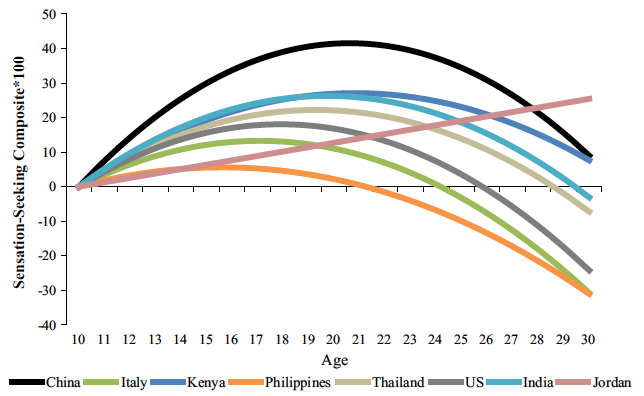Sensation-seeking is defined as the need for varied, novel and complex sensations and experiences, along with the willingness to take physical and social risks for such experiences. It is highly related to, but not necessarily the same as, risk-taking behaviour.
Dopamine is a neurotransmitter involved in several important human behaviours. Dopamine initiates exploratory behaviours such as risk-taking, sensation-seeking, novelty-seeking and increased independence. It also facilitates cognition. Some have proposed that a re-modelling of dopamine systems may be responsible for adolescent-specific reward- and sensation-seeking behaviours. Dopamine projections terminate in various structures of the limbic system, the medial PFC and other cortical regions. It is thought that adolescence is a period of particularly high concentrations of dopamine, predominantly in the PFC. Sensation-seeking seems to increase throughout adolescence across cultures, and plateau in the late teens/early 20s.
 0 on the y-axis represents the mean at age 10, therefore anything above the x-axis is an increase from age 10 and anything below the x-axis is a decrease. Steinberg et al., (2016)
0 on the y-axis represents the mean at age 10, therefore anything above the x-axis is an increase from age 10 and anything below the x-axis is a decrease. Steinberg et al., (2016)
**
Click on the topics below to find out more about the science in the film.
Sleep *** Hormonal Changes *** Prefrontal Changes
Inhibitory Control *** Mental Time Travel *** Limbic Changes
Sensation Seeking *** Risk taking *** Social Development
Theories of Adolescence *** Evolution *** Mental Health
Neuroconstructivism *** Educational Neuroscience
About
**
Use the form below to share how your understanding of this topic has influenced, or will influence, your teaching. What tips or strategies do you have that are based on this science? We will share this anonymous feedback on our website so that other teachers can try out your ideas. Thank you for contributing!
